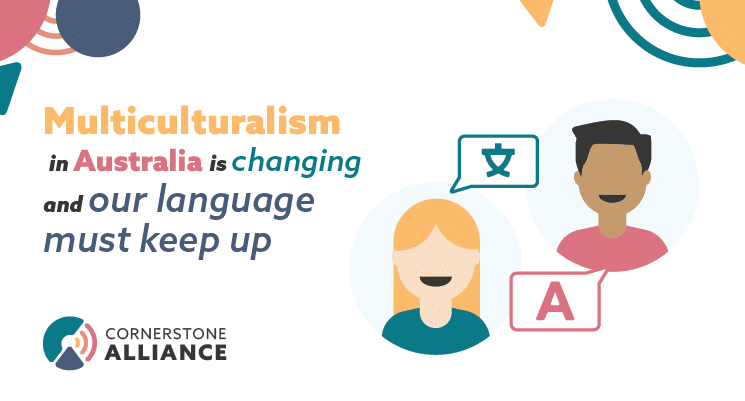Written by Samoda Silva
From promoting an openly racist and discriminatory stance with the White Australia Policy from the time of federation, to welcoming around 395,000 migrant arrivals from across the globe in 2021-22, Australia has made significant progress to become one of the most multicultural countries in the world. Even now, with continual developments in foreign policy and the effects and impact of the COVID-19 pandemic, the story of multicultural Australians continues to evolve. With this comes a simple truth and an indisputable reality:
Multiculturalism in Australia is changing, and our language needs to keep up.
To foster Australian culture and promote the nation as a welcoming and thriving hub for multicultural communities, it’s time we retire the archaic language of the past and look to change the way in which we talk about diversity to reflect the status quo in 2023.
Now, this is not a new concept. In the 90s, Australian authorities moved away from the term ‘Non-English-Speaking Background (NESB)’ to describe migrant population groups to the term ‘Culturally and Linguistically Diverse (CALD)’, acknowledging that diversity extends beyond language proficiency. The term ‘CALD’ is still in use today, yet it is also being debated on its limitations, highlighting the perpetual evolution of language and the need for ongoing discussion.
Here are three terms in the multicultural policy space that are being reconsidered in the 21st century.
Note: It should be noted that defining culture is not always straightforward, and the language of diversity is constantly evolving and largely subjective. Therefore, it is essential to approach discussions surrounding the language of multiculturalism with a willingness to listen to diverse perspectives and interpretations. Additionally, acknowledging and respecting the nuance of these concepts can lead to more meaningful and productive conversations about cultivating inclusive environments.
Ethnic
South Australian organisations, in particular, have been proactive about phasing out the use of the word “ethnic”. This is evidenced by the change of the ‘South Australian Multicultural and Ethnic Affairs Commission’ (SAMEAC) to the ‘South Australian Multicultural Affairs Commission’ (SAMAC) and the rebranding of the ‘Ethnic Schools Association SA’ to ‘Community Language Schools SA’.
In consultation with SAMEAC and community groups, it was outlined that the term was potentially “outdated and potentially divisive”, as it implies the existence of an outgroup rather than a holistic societal structure.
Minority
This term has been used to describe groups of people who represent cultures outside of the majority population. However, this term has faced criticism for framing certain groups as inferior and not reflecting groups that may not always be numerically smaller than the majority population. As a result, alternative terms like ‘underrepresented groups’ or ‘marginalised communities’ are being favoured to emphasize structural inequalities.
Multiculturalism vs Interculturalism
While ‘multicultural’ is still commonly used to convey the diversity of cultures, beliefs and backgrounds, there are calls for a more active and embracing term that extends beyond mere recognition of multiple cultures.
The South Australian Multicultural Charter and the South Australian Multicultural Act (2021) are prime examples of this shift. For the first time in Australian legislation, the Act introduced the concept of ‘interculturalism’. This idea involves recognising that we are all active participants and contributors to a multicultural society, and as such, we should be more aware of our own and others’ cultures, engage in dynamic and productive interaction between diverse groups, and recognise the contributions of multicultural people to enrich our society. Furthermore, unlike multiculturalism, interculturalism acknowledges the coexistence of multiple cultures within a single space rather than separating them into separate realms.
Defining culture is intricate and ever-changing. However, we all should be aware of the power of language and its ability to reflect, lead and limit our attitudes and discussions. This is why the language of multiculturalism must keep up with contemporary practices and notions, and also be one step ahead to guide our conversations. Making efforts to choose the most inclusive, considerate language can create an environment where everyone feels valued, respected, and involved. Through conscious language choices, we can break down barriers, bridge cultural gaps, and build a more harmonious and inclusive society.
